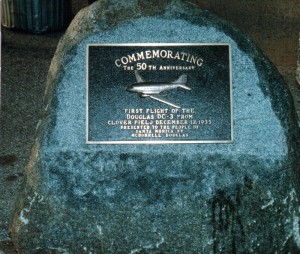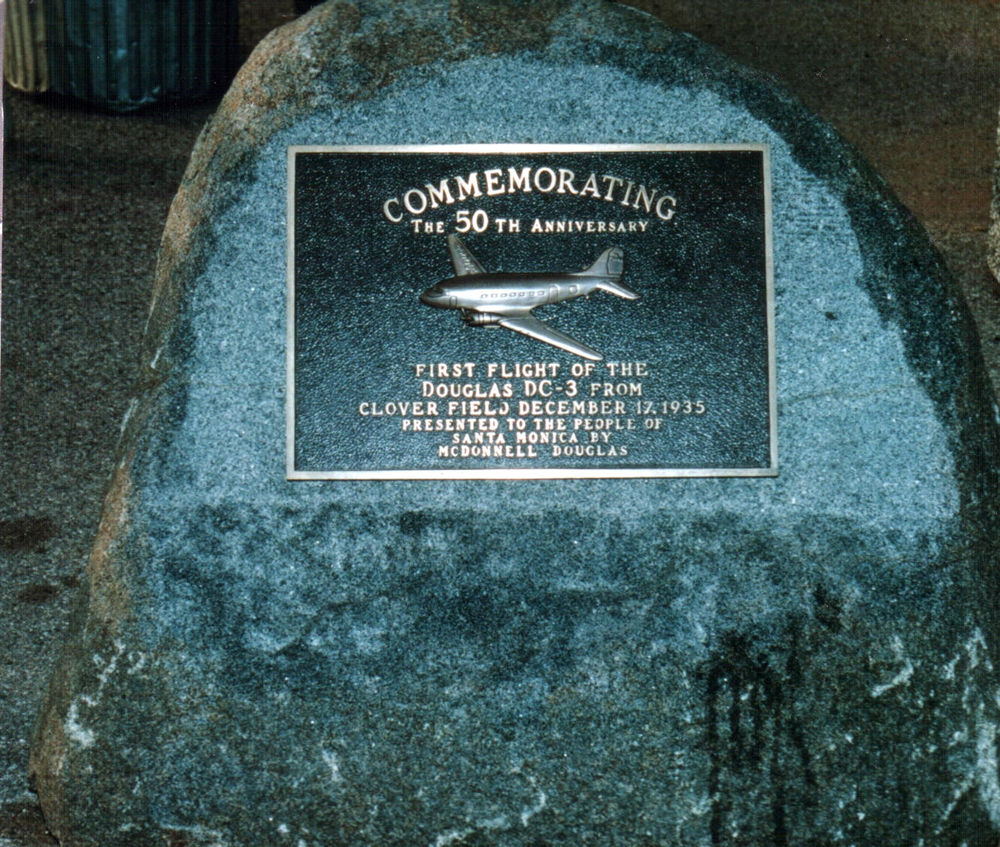
This plaque commemorates the first flight of the Douglas DC-3 in 1935. Unofficial operations began on a grass strip in 1919.
By Henry M. Holden
The clock is counting down for Santa Monica Municipal Airport (SMO). Unless there’s a change in thinking, the year 2015 will see the curtain fall on this historic airport.
SMO is one of the oldest fields in the U.S.; records indicate the first flights at SMO took place from an informal grass landing strip in 1919. It hosted the starting point for the Douglas World Cruisers in 1924, and was once the home of the Douglas Aircraft Company. Douglas launched most of his DC series of prop-driven transports from runway 21/3.
During World War II, for national security reasons, the government leased the airport from the city to provide protection for the Douglas plant. At the end of the war, the city and the War Assets Administration executed an “instrument of transfer” in August 1948, transferring it back to the city as municipal property. The agreement said it must remain as an airport in perpetuity; otherwise, it could revert to federal ownership. Therefore, if Santa Monica decided to close the airport, the federal government could step in and sue to enforce the transfer agreement.
Barry Schiff, a commercial pilot, author and chairman of the Santa Monica Airport Association, has been involved in the battle to keep SMO open from the beginning.
“The big problem is what does ‘in perpetuity’ mean?” asked Schiff. “Although the dictionary will say it’s ‘a time without end,’ it can’t possibly mean that, because there may not be airplanes a hundred years from now, for example. Maybe all airplanes will be vertically rising, and we won’t need long runways. Alternatively, a judge can simply say 60 years is long enough. We really don’t know, and the courts will determine what it means. So far, the courts have been willing to uphold in favor of the federal government.”

SMO hosted the start of the four Douglass Cruisers on their trip around the world. One of the World Cruisers is in the foreground. In those days, developers hadn’t yet seen the value of the land.
Airport noise had become an environmental issue.
“The debacle began in the late 1970s, when homeowners living at the end of the departure end of runway 21 realized that noise had become a popular environmental issue,” Schiff said. “Santa Monica voted to ban jets larger than Category B-II from the airport. Several aviation organizations responded by suing for relief in federal court. The city reacted by attempting to impose choking operational restrictions such as banning touch-and-goes on weekends, a 100-decibel single engine noise limitation, a ban on helicopter flying, and a departure curfew between 11:00 p.m. and 7:00 a.m.. Years of courtroom litigation saw the federal Court of Appeals rule that the city had the right to impose reasonable noise restrictions on operations.
“The city keeps coming up with new ways to diminish the airport’s value. Successive city councils have chipped away at the usefulness of the facility. Most people want the airport. It’s the city counsel that wants the airport for other purposes.”
In 1982, the city attempted to evict short-term leaseholders and responded to the lawsuits by taking punitive actions. They closed the observation deck and declared that the underground fuel tanks were no longer legal. The airport removed the tanks, replacing them with aboveground tanks.
In 1984, the city settled the federal lawsuit with the FAA, AOPA and others resulting from the ban. As part of the settlement, the city agreed to keep the airport open and accessible through 2015, with some restrictions, which included the departure curfews; helicopter restrictions’ a 95-decibel SENL; and pattern restrictions on weekends, holidays and evenings.
In July 2005, SMO started charging a landing fee to transient pilots.
“It’s now up to $4, and you don’t know you’re being charged until you get a bill in the mail,” said Schiff. “This is a result of a negotiated agreement with the FAA. The city had tried to impose much higher fees in an attempt to discourage larger, louder aircraft, but the FAA said that was unjustly discriminatory and prohibited by federal grant agreements. This fee passes FAA muster and is in line with landing fees charged at some other GA airports across the country.”
More pollution studies
In April 2007, a bill was introduced that would have required the California Air Resources Board to study air pollution at SMO by collecting taxi and idle times of jets and turboprops for one year. AOPA feared the environmental study could be used to restrict operations at the airport—and could spread to airports throughout California.
“This was an important issue that members needed to act on,” said Greg Pecoraro, AOPA vice president of regional affairs. “More airports are at stake than just Santa Monica.”
In September 2007, the bill died in committee.
“We hope this marks the end of legislative efforts to impose another unnecessary environmental study at Santa Monica,” Pecoraro said. “This is the second year that state lawmakers rejected legislation affecting this vital airport. So far, there have been seven environmental studies of the airport.”
The noise issue is the tip of the iceberg.
“At the core of the issue is the 215-acre patch of land on which the airport sits,” Schiff said. “While it’s only five percent of the useable land in the city, it’s one of the most valuable pieces of real estate. One study indicated that by fully developing the land, the city would double its revenue. The city counsel also sees it as a means to expanding its political power base. By building low-cost housing and the development of other social programs, it shows its beneficence on its citizens.”
He said the last of the leases on the control tower, a VORTAC transmitter and VASI visual approach slope indicator, expire in 2015.
“Virtually everything else is on a month-to-month basis, which gives the city a lot of latitude,” he said. “They could ask them to leave tomorrow. It’s also the year that there’ll be no more funds available. The FAA invested money in the airport, and the airport is obligated to remain open for 20 years beyond the time of that investment.
“There is an airport commission, but it serves at the pleasure of the city council, which is clearly disposed to closing the airport. The city recognizes that they can’t close the airport, so instead, they want to change its form, meaning restrict the operations there. Perhaps shorten the runway and reduce, however they can, the viability of the airport. By fighting this war of attrition, the FAA may one day say the airport isn’t worth the effort and let it close.”
On March 25, 2008, the Santa Monica City Council adopted an ordinance restricting aircraft operations at SMO to aircraft designated by the FAA as Category C and D aircraft, which have approach speeds of 121 knots at their maximum landing weights.

Modern Santa Monica shows land development crushing the airport on all sides. If the airport closes, more housing is a certainty.
“These are the larger business jets,” Schiff said. “If you come in lighter, and at a slower speed, you’d still be banned. Only aircraft in the FAA designated A & B categories would be allowed to operate. They cloak this under safety because it sounds better that way.”
The FAA had issued a cease and desist order on April 24, the same day the ban was to take effect and one day after the city refused to withdraw a letter warning pilots that they could face fines and even jail time for violating the ban. After receiving the order, city officials held meetings with the U.S. Attorney’s office and did not immediately enforce the ban.
“In its request that the city withdraw the letter, the FAA pointed out that the legality of the ban was under review, and that as a federally obligated airport it must remain open and accessible,” said Schiff. “The FAA also warned the city that it would pursue a cease and desist order if the city didn’t withdraw its enforcement letter. The FAA accused the city of attempting to circumvent the agency’s authority as the final arbiter of aviation safety.”
On April 28, a federal judge issued a temporary restraining order enjoining the city’s enforcement of the ordinance until a hearing on the preliminary injunction was held on May 15, 2008.
“The next day, the court issued a preliminary injunction preventing the city from enforcing its ordinance, and requiring the city to permit the use of SMO by category C and D aircraft for the duration of the lawsuit,” Schiff said. “This isn’t the end of the issue, but the FAA and the court are sending a message to Santa Monica and other airports that arbitrary restrictions to federally funded airports will not be tolerated..”
The real problem is that there are so many airports being threatened that no single organization has the manpower to stand up to all theses potential closures.
“We have to keep SMO open and viable for commerce,” Schiff said. “There aren’t many places business jets can go. Van Nuys is almost saturated, and forget about them going to LAX. Ultimately, the instrument of transfer may be the document that saves the airport. We think it’ll be difficult to close SMO since it’s a reliever for LAX, but they’ll keep trying.”












